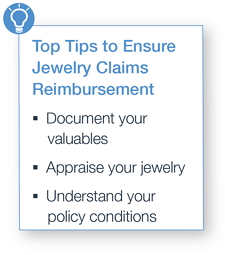Tips to ensure proper coverage and replacement of lost or
stolen precious items.
Statistics
Canada reports that breaking and entering is the most common form of property
crime.[1] In addition to apparel and electronics, jewellery
including rings, necklaces, watches and other luxury items are the most
frequently cited items among home-loss claims.[2] And with
higher prices for gold and silver, the cost of insurance claims has increased
as well.
While jewellery
is covered under most standard home insurance policies, carriers often limit coverage
to about $1,500 per item, though some may offer higher limits. If you own
valuable jewellery that couldn’t be repaired or replaced for this amount, you
need to consider increasing your insurance coverage.
One option
is to “schedule” individual pieces of jewellery through the purchase of a supplemental
policy, like jewellery insurance or a valuable articles policy. These policies
generally offer broader coverage than a standard home insurance policy. For
instance, if you lose an earring while showering, it would be replaced under
this type of policy, but under not a standard policy. Supplemental policies
range in price, but expect to pay about $1-2 per $100 value of the item per
year.
No matter what
jewellery insurance option you choose, there are certain steps you can take to
protect yourself in the event of a loss. Carriers are experiencing an
increasingly high volume of claims in this area. So take
the following precautionary measures to make sure you are properly and
efficiently reimbursed in the event of a claim.
 Document your
valuables.
Insurance carriers will tell you that the most important thing you can do
is to document all your valuables and store that information in a safe
place, such as a safety deposit box. The inventory should include
receipts, appraisals, certificates of authenticity and photographs. Cataloging
your jewellery will go a long way in creating a smooth insurance
settlement process.
Document your
valuables.
Insurance carriers will tell you that the most important thing you can do
is to document all your valuables and store that information in a safe
place, such as a safety deposit box. The inventory should include
receipts, appraisals, certificates of authenticity and photographs. Cataloging
your jewellery will go a long way in creating a smooth insurance
settlement process. - Have your jewellery
appraised. For
items without a receipt, it’s a good idea to get the piece appraised to
make sure you receive the proper replacement cost value (RCV). All jewellery
covered by a supplemental policy must be officially appraised, as well. Insurers
have specific guidelines for what constitutes a proper appraisal, so make
sure yours will adhere to their requirements before scheduling it. Since
the price of gemstones changes over time, it’s important to have your
items reappraised every few years.
- Understand the
conditions of your policy. Read your jewellery insurance policy thoroughly to
understand exactly how and when your jewellery is insured. For instance,
will your coverage change if you move to a different neighbourhood? Will
your item be replaced if it is lost in a fire? What if it’s lost on the
beach? Or what if you lose the centre gem but not the entire ring – does
your policy cover partial loss? Reading the fine print will help you spot
any gaps in coverage and give you the opportunity to purchase additional
protection before anything unfortunate happens.
While
nothing can replace the personal loss of a cherished ring, necklace or watch, jewellery insurance can at least reimburse you
for the monetary value of the item. If you have special, high-value pieces that
you want to protect, talk to your HUB agent about what your current coverage
offers and the supplemental insurance options available.
[1] http://www.statcan.gc.ca/pub/85-002-x/2015001/article/14211-eng.htm#a13
[2] http://www.propertycasualty360.com/2014/03/01/jewelry-costs-pc-insurers-a-pretty-penny?page=2